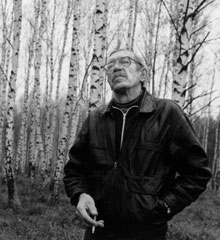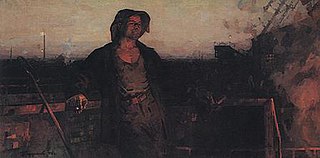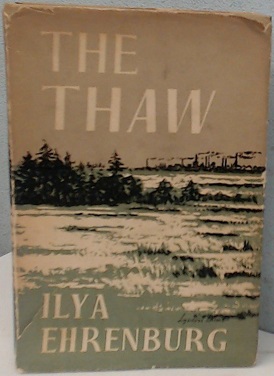Related Research Articles
Soviet nonconformist art was Soviet art produced in the former Soviet Union outside the control of the Soviet state started in the Stalinist era, in particular, outside of the rubric of Socialist Realism. Other terms used to refer to this phenomenon are Soviet counterculture, "underground art" or "unofficial art".

The Bulldozer Exhibition was an unofficial art exhibition on a vacant lot in the Belyayevo urban forest by Moscow and Leningrad avant-garde artists on 15 September 1974. The exhibition was forcefully broken-up by a large police force that included bulldozers and water cannons, hence the name.

Ernst Iosifovich Neizvestny was a Russian sculptor, painter, graphic artist, and art philosopher. He emigrated to the U.S. in 1976 and lived and worked in New York City.
Oleg Vassiliev was a Russian painter associated with the Soviet Nonconformist Art style. Vassiliev emigrated to the United States, arriving in New York City in 1990 and later lived and worked in St. Paul, Minnesota.
Russian political jokes are a part of Russian humour and can be grouped into the major time periods: Imperial Russia, Soviet Union and post-Soviet Russia. In the Soviet period political jokes were a form of social protest, mocking and criticising leaders, the system and its ideology, myths and rites. Quite a few political themes can be found among other standard categories of Russian joke, most notably Rabinovich jokes and Radio Yerevan.
The Moscow Conceptualist, or Russian Conceptualist, artistic and literary movement began with the Sots art of Komar and Melamid in the early 1970s Soviet Union, and continued as a trend in Soviet nonconformist art into the 1980s. It attempted to subvert socialist ideology using the strategies of western conceptual art and appropriation art. It was an artistic counterpoint to Socialist Realism, and the artists experimented aesthetically in a wide range of media, including painting, sculpture, performance, and literature. As Joseph Bakshtein explained, "The creation of this nonconformist tradition was impelled by the fact that an outsider in the Soviet empire stood alone against a tremendous state machine, a great Leviathan that threatened to engulf him. To preserve one's identity in this situation, one had to create a separate value system, including a system of aesthetic values."

Vladimir Nikolaevich Nemukhin was a Russian artist. Nemukhin was associated with the 'Lianozovo Group' along with Oscar Rabin, Valentina Kropivnitskaya (1924-2008) and Lidiya Masterkova.

The American National Exhibition, held from July 25 to September 4, 1959, was an exhibition of American art, fashion, cars, capitalism, model homes and futuristic kitchens. Held at Sokolniki Park in Moscow, then capital of the Soviet Union, the exhibition attracted 3 million visitors during its six-week run. The Cold War event is historic for the "Kitchen Debate" between then-Vice President of the United States Richard Nixon and Soviet Premier Nikita Khrushchev, held first at the model kitchen table, outfitted by General Electric, and then continued in the color television studio where it was broadcast to both countries, with each leader arguing the merits of his system, and a conversation that "escalated from washing machines to nuclear warfare."
Ülo Ilmar Sooster was an Estonian nonconformist painter.
Igor Chetvertkov is a Russian painter, draftsman, and theater designer. Chetvertkov started his career as a scenographer and has created sets for 50 performances. He has participated in 100 exhibitions both in Russia and abroad. In 1977 he graduated from Moscow College of Art with a degree in drama. Having studied under A. G. Tyshler, he worked in the workshop of S. B. Benediktov.

Igor Petrovich Veselkin was a Russian Soviet realist painter, graphic artist, scenographer, stage designer, and art teacher, professor of the Repin Institute of Arts, who lived and worked in Saint Petersburg. He was a member of the Saint Petersburg Union of Artists, and regarded as one of the representatives of the Leningrad school of painting.

Soviet art is the visual art style produced after the Russian Revolution of 1917 and during the existence of the Soviet Union, until its collapse in 1991. The Russian Revolution led to an artistic and cultural shift within Russia and the Soviet Union as a whole, including a new focus on socialist realism in officially approved art.
The year 1960 was marked by many events that left an imprint on the history of Soviet and Russian Fine Arts.

The Khrushchev Thaw is the period from the mid-1950s to the mid-1960s when repression and censorship in the Soviet Union were relaxed due to Nikita Khrushchev's policies of de-Stalinization and peaceful coexistence with other nations. The term was coined after Ilya Ehrenburg's 1954 novel The Thaw ("Оттепель"), sensational for its time.

Igor Vulokh was a Russian nonconformist artist of the 1960s, a leading exponent of abstraction in Russian art.

The All-Union Art Exhibition Dedicated to the 40th Anniversary of the Great October Socialist Revolution was one of the largest art exhibitions in Soviet history. Exhibition took place in Manezh Exhibition Hall from November 5, 1957, to May 1958.

The Thaw is a short novel by Ilya Ehrenburg first published in the spring 1954 issue of Novy Mir. It coined the name for the Khrushchev Thaw, the period of liberalization following the 1953 death of Stalin. The novel marked a break both from Ehrenburg's earlier purely pro-Soviet work, and from previous ideas about socialist realism.

Anna Andreeva was a Russian textile designer. Andreeva was a leading artist at the Red Rose Silk Factory in Moscow from 1946 until 1984.

Galina Osetsimskaya was a collector of Soviet Nonconformist Art and Russian contemporary art.

Second Russian avant-garde was a movement in Russian art, primarily in fine arts and poetry, which began in the mid-1950s and ended in the late 1980s. The movement's birth is associated with the Khrushchev Thaw and with the 6th World Festival of Youth and Students in 1957 in Moscow. The concept was introduced into cultural circulation by Mikhail Grobman during his visit to the Tel Aviv Art Museum in the late 1950s, and by the late 1980s the term had become a solidified historical movement.
References
- ↑ Reid, Susan Emily (2005). "In the Name of the People: The Manege Affair Revisited". Kritika: Explorations in Russian and Eurasian History. 6 (4). Slavica Publishers: 673–716. doi:10.1353/kri.2005.0058. S2CID 159693587.
- ↑ Sjeklocha, Paul; Mead, Igor (1967). Unofficial Art in the Soviet Union . University of California Press. p. 100.
- ↑ "Манежный скандал" Хрущева (in Russian)
- ↑ Фёдор Ромер, "Рыбий глаз", Еженедельный Журнал, January 15, 2002 (online copy)
- ↑ Никита Хрущев, отец русского авангарда, Kommersant , December 16, 2002